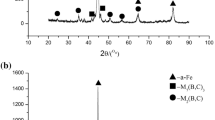Abstract
In this paper, five kinds of magnesia carbon refractories commonly used in the metallurgical industry were selected to explore their thermal shock resistance. The experiment results showed that the maximum residual flexural strength of sample 2# was 8.07 MPa after three thermal shock cycles under the stress of not more than 0.3 MPa, representing the best thermal shock resistance according to the standard. The accuracy of this result was verified through the tests for the linear expansion performance, ratio of high-temperature flexural strength (Re) to Elastic modulus (E). Sample 2# showed a basically identical linear expansion rate with that of the high-carbon sample at the test temperature of 1200–1500 ℃. The Re/E index of sample 2# was relatively high at high temperatures. The comprehensive analysis identified that sample 2# performed the best thermal shock stability. Therefore, sample 2# can serve as qualified refractories of a converter bath.
Access this chapter
Tax calculation will be finalised at checkout
Purchases are for personal use only
Similar content being viewed by others
References
Harada T (1993) Thermal shock resistance equipment. Taikabutsu Overseas 13:44–51
Brochen E., Clasen S, Dahlem E (2016) Determination of the thermal shock resistance of refractories. Refractories Worldforum: manufacturing & performance of high temperature materials. pp 1:79–85
Watanabe K, Yabuta K, Okamoto H, Yamamoto, H (1995) Oxidation behavior of MgO-C bricks with various additives. Unitecr’95 Congress. In: Proceedings of the unified international technical conference on refractories 4th biennial worldwide conference on refractories, Global development of refractories, Kyoto, 9–22 Nov 1995
Barthel H (1997) Carbon-containing magnesia and magnesia carbon bricks. Pocket manual refractory materials. Vulkan-Verlag, Essen/Germany
Fu** Q (2002) Development of low-carbon MgO-C bricks. Foreign refractory materials 5:56–57
Acknowledgements
We thank XM and LD company laboratories for the testing equipment provided.
Author information
Authors and Affiliations
Corresponding author
Editor information
Editors and Affiliations
Rights and permissions
Copyright information
© 2022 The Minerals, Metals & Materials Society
About this paper
Cite this paper
Changhai, L., **g, L., Renxiang, L., Shouxin, T. (2022). Experimental Study on Thermal Shock Resistance of Magnesia Carbon Brick. In: Peng, Z., et al. 12th International Symposium on High-Temperature Metallurgical Processing. The Minerals, Metals & Materials Series. Springer, Cham. https://doi.org/10.1007/978-3-030-92388-4_48
Download citation
DOI: https://doi.org/10.1007/978-3-030-92388-4_48
Published:
Publisher Name: Springer, Cham
Print ISBN: 978-3-030-92387-7
Online ISBN: 978-3-030-92388-4
eBook Packages: Chemistry and Materials ScienceChemistry and Material Science (R0)




